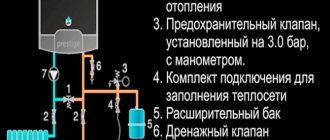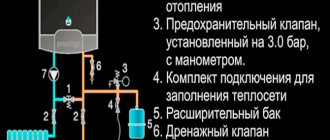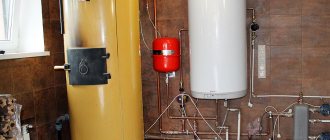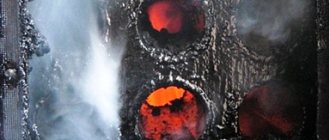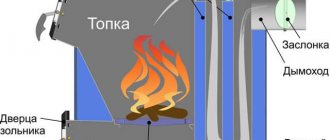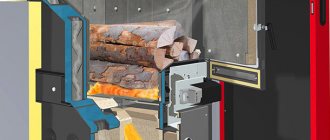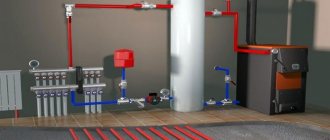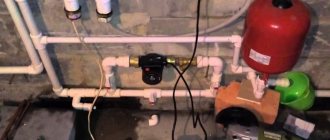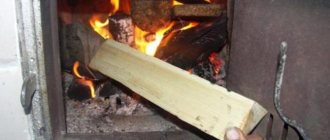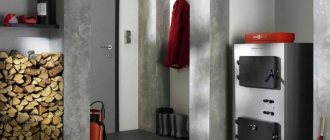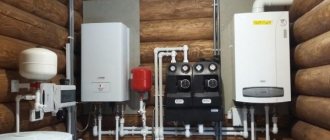List of structural elements of the Stropuva boiler.
In the previous article we talked about long-burning stoves for homes, cottages, bathhouses, and how to heat them. Today we will talk about two units that are similar in their principle of operation - the Lithuanian boiler Stropuva and the Bubafonya from Kolyma, and we will even try to compare them. Those who think whether it is possible to make a Stropuv boiler with their own hands will have to be disappointed, most likely this will not be possible.
Some structural elements are very complex and can only be manufactured in production conditions using machine tools. But a domestic, simplified analogue can be assembled in a day. Of course, it does not have such high characteristics as factory units, however, it will heat a dacha or garage in no time. The option is super economical and practical, like the AK-47.
Description of connecting the Stropuva boiler piping:
Description of the scheme
The coolant heated in the boiler passes through steel pipes with a diameter of 25 mm for boilers S40, S20, S10, S8, S7. Air is removed from the boiler through an automatic air vent (1). A safety valve of 1.5 atmospheres is installed on the external circuit of the boiler. The coolant is directed along the external circuit through the valve to the hot water boiler (3).
After heating the boiler, the coolant flows back into the outer circuit of the piping unit. After the boiler (3), a selection is made to an additional radiator (4) which, in the event of a power failure, can operate as a gravity-fed one. The additional radiator (4) must be connected independently. It is necessary to prevent the boiler from overheating when the circulation pump (6) is turned off.
The radiator system (5) is connected at the top of the small circuit through a valve with a diameter of 25 mm. The return line of the radiators is fed to the circulation pump through a valve with a diameter of 25 mm. The heated coolant from the boiler enters the heating system manifold and then into the radiator system (5). The cooled coolant flows from the return manifold to the circulation pump (6). The return coolant after the pump (6) is supplied to a three-way mixing valve (7).
The mixing valve (7) is necessary for mixing the coolant in the return and supply lines to prevent the formation of condensation and is necessary for adjusting the temperature regime of the boiler. In the lower part of the circuit, after the mixing valve, a balancing valve (8) is installed with the ability to adjust the passing flow, with the help of which the flow from the circulation pump is distributed so that it is enough to heat the radiators, and at the same time, so that it is sufficient for the boiler
In the return line after the balancing valve, drain valves are installed to recharge and empty the system, as well as an expansion tank (9). The pressure in the expansion tank should be 0.5-0.7 atmospheres. If necessary, an electric boiler can be installed instead of a boiler.
A circulation pump with a power of:
- for boiler 10 kW 25–60 W
- for boiler 20 kW 40–80 W
- for boiler 40 kW 50–100 W
Bubafonya stove with water jacket
Pyrolysis furnace Bubafonya from a gas cylinder with a water jacket.
Finally, we got to the domestic analogue of the Stropuva boiler, which is much simpler to implement, since it has a non-folding pipe for supplying air to the firebox. There are already so many instructions on how to make a Bubafonya stove with your own hands that only a blind person would not have seen them, unless, of course, they were interested in this topic. And why all? Yes, because the process is so simple and if you take the matter seriously, you can get a finished product from scratch in a day. What is the Bubafonya stove made from with your own hands:
- from a gas cylinder;
- from a barrel;
- from pipes
It can be either round or square. Let’s not repeat the same thing, just read the article: “Bubafonya stove from a gas cylinder” - and everything will become clear to you. Today we will consider a version of the product with a water circuit, as if we will try to repeat the principle of operation of the Stropuva boiler. All that is required is to make a simple Bubafonya and insert it into a pipe of a larger diameter. Thus, we obtain a gap in which the coolant will be heated.
Naturally, this space above and below is sealed so that various debris does not get there. What is important when making a Bubafonya stove with a water jacket with your own hands:
- use of heat-resistant steel;
- wall thickness of at least 4 mm;
- the presence of a tap for draining and replenishing water.
Immediately provide a hole in the upper part through the outer and inner walls for installing a chimney into it. There should also be enough space for water. The distance from the outer to the inner wall is about 10 cm. When connecting, do not confuse the supply and return pipes (supply from above).
Reservation of work
The Stropuva boiler will delight you with long-lasting fuel combustion. But even in this case, you can miss the moment of the next bookmark. As a result, the temperature of the coolant in the heating circuit will begin to fall. To prevent this from happening, we recommend installing a backup electric boiler in the circuit. If it detects a temperature drop below the set limit, it will turn on and maintain the set temperature.
Electricity consumption will be small if you don’t forget to add firewood for 2-3 days. The vast majority of the time the boiler will burn, providing heat to consumers. Therefore, you should not expect huge expenses. In addition, the auxiliary boiler does not have to be as powerful as the main one - a model with a power 2-3 times lower is quite enough so as not to make your teeth chatter in the morning. We also recommend working on insulating your home so that it retains the accumulated heat longer.
Manufacturing sequence
Type of homemade installation
- A lid with a small side is cut out of the barrel, for which a grinder is used. A hole is made in the lid right in the middle for a pipe with a diameter of 100 mm.
- Next, a grate is made from wire or corners. In fact, this is a regular grill, where it is important to determine the size of the cells. The smaller they are, the better, especially when it comes to such small fuels as sawdust or husks. By the way, the grate is not used in all models - sometimes you can do without it. If there is one, then it is installed inside the barrel closer to the bottom. Fastening is done by electric welding.
- Now let's move on to making the load - the press. To do this, a round pancake is cut out of a 4 mm thick steel sheet, the diameter of which is 2–3 cm less than the diameter of the metal barrel. A through hole with a diameter of 100 mm is made in it.
- We weld the pipe to the pancake. Please note that the length of the pipe should be 20–50 cm greater than the height of the barrel. Now 4 channels need to be welded on the back side of the pancake. They are needed to weigh down the press and create a small space under it - this will be the combustion zone. The channels are welded in such a way as not to cover the hole in the pancake. The usual fastening pattern is criss-cross.
- In the barrel just above the location where the grate is installed, you need to make a door through which you can clean the boiler from ash and ashes. This device must be sealed using an asbestos cord.
- A through hole is made on the side of the upper part of the barrel, almost near its upper edge, and a small pipe with a diameter of 100 mm is welded to this place from the outside. This will be the location where the chimney will be installed.
- Now you need to take care of the removable cover. The upper part of the barrel, which was cut out, must be brought into proper shape. To do this, its sides are slightly expanded - you can simply tap them with a hammer. It is necessary to weld two handles on the top side, with the help of which the cover will be installed manually. On the outside of the side around the entire perimeter, you need to glue an asbestos cord or a strip of fiberglass, which will contain the smoke coming out of the combustion zone.
At this point, all parts of the boiler are ready, and you can begin adding fuel, as well as assembling the structure.
Procedure for assembling the structure
Attention! The closer you pack the firewood, leaving minimal space between them, the longer it will burn. As for sawdust, everything is simpler - you just need to compact it well.
Combustion chamber
The press is installed on the stacked fuel with the pipe facing up, and the barrel lid is put on it. The chimney is connected to the pipe. Long-burning furnaces have a unique design that ensures the removal of carbon monoxide only through a horizontal pipe. That is, the chimney will not be vertical, but horizontal with a slight upward slope. This is another distinctive feature of long-burning stoves.
Before placing the press, it is necessary to ignite the top layer of fuel. Then the press and lid are installed. In this case, the firewood or sawdust in the combustion zone will simply smolder, releasing a large amount of thermal energy. At the same time, as it burns out, the zone will gradually settle under the influence of the load. Smoke from the combustion of solid fuel comes out of the zone between the gap formed by the walls of the barrel and the edges of the metal pancake. It is then discharged through the chimney. Oxygen enters the combustion zone through a pipe welded vertically to the pancake.
Since the metal from the barrel will become very hot, the structure is considered unsafe in terms of fire. Therefore, experts recommend:
- Install such a stove near walls that are built from non-combustible materials.
- A foundation needs to be poured under a long-burning furnace. It can be concrete or fire brick.
- To increase operational safety, you can install a protective heat shield made of metal or bricks.
How to start a Stropuva boiler
First, you need to purchase a piping kit to connect the equipment to the heating system. We recommend purchasing a kit with the ability to connect an indirect heating boiler. It includes a set of pipes, a safety group, an expansion tank and a circulation pump. Also on sale are kits for connecting underfloor heating.
It is not recommended to use damp firewood - this will interfere with the normal operation of the boiler.
Ignition is carried out in the following way - here are brief instructions for use:
- We load the wood combustion chamber full with the air distributor raised.
- We fill the finished masonry with sawdust.
- Open the flap for switching to wood.
- Open the air damper 3-5 cm.
- We light the top layer, close the loading door, leaving a gap 3-5 cm wide.
- We wait for reliable combustion, close the loading door and immediately lower the air distributor.
Please note that the cleaning door must be closed. A new portion of firewood can be added to the Stropuv boiler at any time, but doing this with coal is dangerous. In any case, the manufacturer recommends that you always wait until the fuel burns out completely before adding a new portion.
In any case, the manufacturer recommends that you always wait until the fuel burns out completely before adding a new portion.
A new portion of firewood can be added to the Stropuv boiler at any time, but doing this with coal is dangerous. In any case, the manufacturer recommends that you always wait until the fuel burns out completely before adding a new portion.
Types and technical characteristics
At the moment, Stropuva is available in three varieties: wood-burning, pellet and universal. Each of these three varieties is designed for a specific type of fuel, but can work on any other, albeit with less efficiency. In total, the line includes 4 standard sizes: 10, 15, 20, 40 kW and a Mini version with a power of 8 kW.
The Stropuva wood-burning boiler is equipped with a special air distributor, which allows efficient burning of wood, and has the following characteristics:
| Model | Mini S | S10 | S15 | S20 | S40 |
| power, kWt | 8 | 10 | 15 | 20 | 40 |
| Room area, m² | 30-80 | 50-100 | 75-150 | 100-200 | 200-400 |
| Efficiency, % | 86,3 | ||||
| Firewood capacity, dm³ | 120 | 150 | 200 | 230 | 360 |
| Chimney diameter, mm | 160 | 180 | 200 | ||
| Burning duration, h | 31,5 | ||||
| Price, rub | 65 000 | 87 150 | 92 348 | 97 545 | 107 730 |
The pellet version is equipped with a distributor for fuel pellets and an air supply manifold. Boilers operating on pellets have the following data:
| Model | Mini SP | S10P | S15P | S20P | S40P |
| power, kWt | 8 | 10 | 15 | 20 | 40 |
| Room area, m² | 30-80 | 50-100 | 75-150 | 100-200 | 200-400 |
| Efficiency, % | 86,3 | ||||
| Pellet capacity, kg | 50 | 70 | 110 | 120 | 200 |
| Chimney diameter, mm | 160 | 180 | |||
| Burning duration, h | 72 | ||||
| Price, rub | 65 000 | 91 350 | 97 072 | 102 795 | 112 980 |
The last representative of solid fuel boilers is universal. These devices can operate on coal, wood, fuel briquettes and pellets. The delivery set includes distributors for all types of fuel, as well as an air supply manifold. They have the following technical characteristics:
| Model | Mini SP | S10P | S15P | S20P | S40P |
| power, kWt | 8 | 10 | 15 | 20 | 40 |
| Room area, m² | 30-80 | 50-100 | 75-150 | 100-200 | 200-400 |
| Efficiency, % | 86,8 | ||||
| Pellet capacity, kg | 50 | 70 | 110 | 120 | 200 |
| Chimney diameter, mm | 160 | 180 | 200 | ||
| Duration of coal combustion, h | 130 | ||||
| Price, rub | 65 000 | 102 700 | 114 608 | 121 380 | 127 995 |
As you can see, from the presented model range you can choose a solid fuel boiler for any room, type of fuel and available budget.
Main models
You can buy a Stropuva boiler in specialized stores that are dealers of the manufacturer, as well as in online stores. The minimum price is 60 thousand rubles for the minimum power model. Let's continue the review with a description of the models being produced.
Stropuva Mini S8
Before us is the smallest wood-burning boiler with a power of 8 kW, designed to heat rooms up to 80 square meters. m. It works on wood briquettes and firewood, is equipped with a safety valve and a thermometer. The heating temperature of the coolant is from +60 to +95 degrees. The maximum pressure in the circuit is up to 1.5 Bar. The efficiency of the model is 85% - a pretty good result for solid fuel equipment. The estimated cost of this boiler is 61 thousand rubles.
Stropuva Mini SP8
This boiler differs from the previous model by supporting operation with pellets. In this mode, it needs to be connected to an electrical network with a voltage of 220 Volts - the electricity is used to operate the fan used in the fuel ignition system. When working with wood and briquettes, the boiler operates in autonomous mode. The remaining parameters are almost 100% similar.
Stropuva S20
One of the most popular models. It allows you to heat residential buildings up to 200 square meters. m. The boiler is built according to an energy-independent scheme; briquettes and ordinary firewood are used as fuel. Burning time is up to 31 hours. If you want to forget about adding fuel for several days, we recommend purchasing the Stropuva S20U modification - it can run on coal, providing up to 120 hours of continuous combustion. The Stropuva S20P model can work on pellets for up to three hours.
Stropuva S40
Before us is the most powerful boiler in the entire line. Its thermal power is 40 kW, combustion duration is up to 31 hours, heated area is up to 400 sq. m. The device is equipped with a rather impressive heat exchanger jacket that holds 58 liters of water. The maximum pressure in the system is up to 2 atmospheres at an average temperature of up to +75 degrees. Over 90 kg of firewood is placed in the combustion chamber of the device. Modifications for working on pellets and coal are also available.
Other models and manufactured modifications
Also on sale are solid fuel boilers from the Stropuva company with a capacity of 15 and 30 kW. They are designed for areas up to 150 and 300 square meters. m. All models discussed in the review are available in three modifications:
- The main one is that the equipment runs only on wood and fuel briquettes (euro firewood).
- With index P – the possibility of working on pellets is provided, burning up to 72 hours.
- With index U - units with the ability to operate on coal, burning time up to 120 hours.
Naturally, the actual burning time may be shorter - it depends on the characteristics of the fuel (type of wood, degree of dryness).
Some people have design requirements for heating equipment
If you really care so much about how the boiler looks, then we have good news - Stropuva produces its equipment in several colors. The main color (and most common) is yellow.
It is possible to purchase boilers in brown, blue, red, green and black colors. Spotted colors are also available (yellow and dirty green).
Appearance and specification of the unit with connection of the boiler and heated floors
Unit components
- Upper collector. Set: supply pipe connector (15), boiler and heating system disconnect valve (14), automatic air valve (19), pressure gauge (18).
- Vertical collector. The manifold is equipped with a valve (7) to the cooling radiator (4, see schematic diagram), and valves for the boiler supply and return lines (16).
- Mixing unit. Set: three-way mixing valve (10), balancing valve (11), circulation pump (5), heating system supply valve (8), return line valve (9), underfloor heating return line valve (16). The circulation pump is installed with union nuts (17).
- Lower collector. Set: valve for installation of the expansion tank (12), drain make-up valve (13), valve intended for repair and maintenance of the boiler (14), return pipe connector (15).
All parts of the unit for assembly are equipped with connectors (6). The expansion tank is not included in the standard package of the unit and is selected individually based on the existing heating system.
System piping
The boiler piping is no different from other solid fuel units
When piping the device, in addition to conventional heating radiators, you need to include a safety battery in the system, on which you do not need to install a thermostat. This convector must be embedded first on the jacket supply pipe through a balancing valve and mounted in such a way that the coolant can move in it by gravity in the event of a power outage.
All other radiators go through a different circuit through regular valves and are connected by return to the circulation pump. The pump itself is bypassed through a three-way valve, which is connected through a second channel to the return pipe of the unit and is controlled by a temperature sensor installed on the return pipe of the batteries.
Among the most popular models of solid fuel boilers Stropuva are the wood-burning unit Stropuva 10S and the universal device Stropuva 20U, with 10 and 20 kilowatts of power, respectively, intended for heating country cottages.
Common mistakes when installing a boiler
| Consequences | |
| The installation is carried out in violation of the requirements for installation and piping of the boiler. | The operation of the boiler will not correspond to the declared technical characteristics and indicators. Premature boiler failure and wear of components. Breaks in the heating system pipeline. |
| Installation of a chimney in violation of the stated requirements. | Lack of draft in the chimney, formation of condensation and air lock in the chimney, unstable combustion of fuel in the boiler, formation of a high concentration of carbon monoxide. Too strong a draft can lead to overheating of the boiler. |
| Pouring a concrete screed for the boiler base of insufficient thickness (less than 10 cm) onto a wooden floor (floor made of combustible materials). | Fire of wooden structures under a concrete foundation. |
Story
The creator of the Stropuva boiler is Lithuanian engineer Edmundas Strupaitis, who in 2000 developed a design in which fuel combustion occurs from top to bottom.
In 2005, the stove received a CE certificate, which confirmed the high quality of the product.
In 2008, in Lithuania, the unit received the title of “Best Product of the Year”, after which the products began to be supplied to Russia and a number of other European countries. To date, Stropuva stoves are sold in most countries of the European Union and the CIS.
The official representative of the Lithuanian company in the countries of the Customs Union is. In 2012, construction began on the production of boilers in Russia. Currently, about 100 dealers in various regions are engaged in selling the plant’s products.
Advantages and disadvantages
The advantages of such models of heat generators include:
- High efficiency of about 87%.
- Long-lasting action on one tab and the absence of excessive heat leading to boiling of water in the system.
- The frequency of cleaning the ash pan is 3-1 times a month.
- The wood-burning version of the equipment is completely energy-independent; it is controlled by a bimetallic plate. Universal models require electrical power of only 20 W.
- The height of the chimney pipe for such devices can be from 4.5 meters.
- The equipment is safe; at critical temperatures, the structure contracts and does not explode.
Boiler power depending on design In practice, Stropuva devices reliably serve for over 10 years.
Disadvantages of the Stropuva boiler:
- The duration of combustion of the unit specified by the manufacturer on different types of fuel is possible only under certain conditions. This includes good insulation of the house and a properly assembled heating system, and this is rarely the case in practice.
- You cannot throw firewood into the firebox during the combustion process - you need to wait until everything burns out, as a result, the effect of cold batteries is always observed.
- The bimetallic regulator does not allow you to accurately adjust the temperature in the system.
The unit is considered energy-independent, but the system to which it is connected requires forced circulation by a pump.
Chimney
To a large extent, the efficiency of the boiler depends on the draft in the chimney pipe. If the draft is poor, the combustion products do not have time to be removed through the chimney and, as a result, the boiler begins to smoke and the room is gradually filled with smoke, and the combustion process in the firebox slows down.
As a rule, lack of traction occurs for several reasons:
Stropuva boiler chimney design
- Insufficiently wide chimney diameter;
- Insufficient chimney height. Should rise 50 cm above the ridge;
- The chimney is filled with combustion products (tar, soot, etc.);
- Incorrect dimensions of the horizontal part of the chimney (length should be at least 20 cm, but not more than 150 cm).
Increased cravings lead to:
- excessive fuel consumption;
- increased combustion temperature;
- increased noise level of the boiler.
When installing a chimney, special attention should be paid to fire safety. The chimney connection to the boiler must be made of metal. It is necessary to regularly clean the chimney itself, as well as its horizontal part, because Accumulations of tar and soot can ignite and cause a fire.
The joints must be well sealed.
Operating principle of the Stropuva boiler
Once the flame is sufficiently hot, it will burn from top to bottom.
Both the original and the analogue of the Stropuva boiler work on the same principle. First you need to load the firebox with bitters. Let us immediately make a reservation that this can only be done after the boiler has completely burned the previous fuel supply, since the source of smoldering must be at the top. To start the boiler you need:
- pull the ring and lift the telescopic air duct;
- remove ash through the bottom door (1-2 times a week);
- fill the firebox with wood or coal, depending on the model of the unit (there are wood-burning and universal ones);
- Set fire to paper or cloth soaked in gasoline on top;
- lower the air duct and close the doors.
As the fuel burns out, the air distributor moves down until it reaches the bottom. The air supply is controlled by a bimetallic plate. The developers have increased the efficiency due to the fact that an air heating chamber is built into the Stropuva boiler design. The latter enters the furnace at a temperature of about 400 degrees. At this temperature, pyrolysis gases ignite. But, unfortunately, the plate loses its properties and every month you need to make adjustments to the settings, and after a year, completely replace it with a new one.
Due to the fact that the air is supplied in doses, it is possible to avoid temperature surges that occur during the operation of ordinary solid fuel boilers. Therefore, the Stropuva boiler piping scheme does without a storage tank, the so-called heat accumulator for the heating system.
Reviews from real owners
While manufacturers do their best to praise their equipment, real owners work with it. They are the ones who can tell how the equipment behaves under constant operating conditions. Reviews from Stropuvo boiler owners will definitely be useful to you when choosing heating equipment for your home.
Tired of traffic jams and noise, I moved with my wife and child outside the city, to a small village. It is quiet and comfortable here, there is no city noise. And there is no gas here. I had to buy a wood-burning boiler from the Lithuanian company Stropuva, since I didn’t want to bother with constantly throwing in new bundles of firewood. The choice turned out to be successful - for a house of 65 square meters. m of the selected boiler turned out to be more than enough. I load the logs once a day, after removing the coals and ash. Hot water is heated in an 80 liter electric boiler. The Stropuva boiler heats just fine, but in reality it still doesn’t last up to 30 hours.
I went to specialized forums to get reviews about these boilers. Some people praise them, while others complain about their low reliability. I made my choice quickly, but in the end I was wrong. It’s really better to spend more money and buy a boiler with a pellet burner and automatic pellet supply. Stropuva also knows how to work with pellets, but automation is difficult. It would be much easier with a bunker for bulk fuel. And the temperature control on Stropuv is not the best. Cleaning away ash is inconvenient. In general, the expensive purchase did not justify itself. It would be better if I took a universal boiler with a pellet burner, which could later be converted to gas.
As with everything, it has its drawbacks. When you start cleaning, smoke pours out in all directions from the still burning coals, since there is no grate here. I can’t understand how anyone could even think of doing without an ash pan. I fixed the problem, but spending almost 100 thousand rubles to fix the manufacturer’s defects yourself is an incredibly interesting activity. Secondly, reloading firewood is very inconvenient, the heat radiates into your face. Moreover, it is not recommended to do this, they say, it is necessary for the firewood to burn out completely. But in the evening there is no time to think about it - I want to sleep, and not wait for the logs to burn out. What I liked is that it heats up quickly, literally after an hour of operation the rooms become warm. Stropuva burns for a long time, at least a day. In cold weather, the burning time is reduced, but this is not so critical. For hot water, I installed a boiler in the system; in the summer it will work from the built-in heating element.
Types of schemes
Today there are several strapping schemes. It is possible to talk about which piping of solid fuel boilers is better or more efficient only after a detailed analysis of the heating design features. For example, the simplest scheme is to connect the boiler to a gravity system. This scheme is quite simple, but it provides not only a high level of efficiency, but also the most important thing in the work - safety.
Connecting the boiler to the gravity system
With such a scheme, it is mandatory to have an open or membrane type expansion tank in the scheme. In the first case, the location of the tank plays a huge role, and in the second, the presence of a safety valve.
The piping of solid fuel boilers according to this scheme is very simple, but poorly controlled. Constant monitoring of fuel and its high consumption require improved design.
https://youtube.com/watch?v=Ef4t5uo2KAk
The circuit can be “outwitted” if a three-way thermal valve is inserted into the system. In this case, the set coolant temperature will be maintained by mixing water from the return to the supply. A design solution with a pump, thermoelement or when using low-power solid fuel boilers is possible.
The valve is installed on the return flow of the coolant and when the temperature of the coolant rises above normal, the automation will block access to mixing.
The wiring diagram for a solid fuel boiler can be presented in different designs, but some features are common.
Stropuva boiler connection diagram
Piping diagram with backup heater, hot water boiler and heated floor.
After the purchase, when filling out the documents, the seller will ask you: “Do you need the help of a specialist in installing the heater?” Do not rush to answer: “No.” The connection diagram for the Stropuva boiler is somewhat different from other types of solid fuel boilers. On the official website you can find three strapping options:
- with backup heater, hot water boiler and underfloor heating system;
- only with boiler;
- with a boiler and low-temperature underfloor heating system.
Maybe for some it is, as they say, “a piece of cake,” but for a person without specialized knowledge, these schemes cause stupor. This is not to mention connecting the Stropuva heating boiler yourself. In general, it is better to use the services of experts in this matter. By the way, opinions have been heard more than once on the forums about the complexity of tying this equipment.
Consumer reviews ↑
We were able to collect several reviews from conversations with users of Stropuva boilers in Russia.
Vasily Nikolaevich Nazarov: Before last season, I bought an S20U boiler for my woodworking workshop. Once every 5-6 days you fill a full bunker with coal - and that’s it, no problems. With pieces of wood, of course, there is more hassle, but I still need to put them somewhere.
Oleg Vladimirovich Serov: The main thing is to correctly determine the required power. There is no point in taking based on the principle: the more, the better. Each model will be effective where it is designed, and the price will be higher - why overpay?
Andrey P.: I have a dacha, there’s not even light there always. At first I tried to heat it with gas from cylinders, it was a hassle and too expensive. Now I have installed a small wood-burning unit with ten kilowatts, the car has enough firewood for the winter. I heat it 2-3 times a week, the house is 6x12 meters plus massandra, I haven’t seen any shortcomings yet.
For using wood materials as fuel and heating buildings up to 100 square meters. meters, it is enough to purchase a Stropuva S10 boiler (power 10 kW) costing about 80 thousand rubles. A universal solid fuel unit model S40U, capable of heating a room of at least 200 square meters. meters will cost the buyer more - about 120,000 rubles.
Wiring diagram for a Stropuva solid fuel boiler with a buffer tank and a circulation pump.
- Safety valve for pressure 1.5 bar *
- Air vent
- Balance valve ø 15
- Reduction ø 25 – 15
- Tee ø 25
- Tee ø 25-15
- Coupling ø 25
- Nipple ø 25
- Detachable coupling ø 25 internal.
- Elbow ø 25 int.
- Reduction ø 32 – 25
- Ball valve ø 25 internal.
- Elbow ø 25
- Thermostatic valve DT 25
- Detachable coupling ø 25
- Circulation pump
- Balancing valve ø 25
- Valve ø 15
- Three-way valve ø 25
R – to/from radiators F – to/from floor heating B – to/from boiler/s
K2 - to/from other boilers/s
For all boiler models, the piping units are assembled from ø 25 parts.
ATTENTION *The 1.5 bar pressure safety valve is screwed into the coupling on the boiler. Instead of a tee (5), use an elbow (10)
Description of operation of circuit No. 1
The circulation pump (P) supplies coolant from the heating system, driving it through the boiler. The coolant, passing through the boiler, heats up. Through the balance valve (bk1), the heated coolant enters the nearest radiator (without a thermal valve), which, in the event of a power failure, can operate as a gravity radiator. The reserve boiler must be connected to the taps (k2), the boiler for preparing hot water to the tap (b).
The heated coolant passes through the reserve boiler (2k), which turns on after the main boiler (1k) stops burning, or when the main boiler (1k) supplies hot coolant, turns off. If the system has a reserve boiler (2k), the valve (2) is closed, and if it is absent, it is open.
The heated coolant from the main boiler (1k) passes into the reserve boiler (2k) and enters the indirect heating boiler (B). After heating domestic water (DHW), the coolant enters the radiator system.
(bk3 – 17) – balancing valve designed to regulate the flow. With its help, the flow from the circulation pump is distributed so that it is enough to heat the radiators, and at the same time, so that it is sufficient for the boiler itself. The total flow volume depends on the power of the circulation pump and can be changed by switching the pump speed settings.
A circulation pump with a power of:
- for boiler 10 kW 25–60 W
- for boiler 20 kW 40–80 W
- for boiler 40 kW 50–100 W
(bk1 – 3) – balance valve of the protective gravity radiator, with the help of which the flow is adjusted so that the radiator return pipe is approximately 40°C colder than the supply pipe.
Specification No. 2 of parts of the prefabricated boiler room assembly
- Pressure safety valve 1.5 bar *
- Air vent
- Balance valve ø 15
- Reduction ø 25 – 15
- Tee ø 25
- Tee ø 25 – 15
- Coupling ø 25
- Nipple ø 25
- Detachable coupling ø 25 internal.
- Elbow ø 25 int.
- Reduction ø 32 – 25
- Ball valve ø 25 internal
- Elbow ø 25
- Three-way valve ø 25
- Nut connection ø 25
- Circulation pump
- Balancing valve ø 25
- Valve ø 15
R – to/from radiators B – to/from boiler/s
For all boiler models, the piping units are assembled from ø 25 parts.
ATTENTION The 1.5 bar pressure safety valve is screwed into the coupling on the boiler. Instead of a tee (5), use an elbow (10)
Description of operation of circuit No. 2
The circulation pump (P) supplies coolant from the heating system, driving it through the boiler. The heated coolant from the boiler (1k) flows through the indirect heating boiler (B). If the diameter of the incoming pipes of the boiler is sufficient, the valve (3) closes and the entire coolant flow goes through the boiler, which is connected in series, so the water in it heats up faster.
After heating domestic water (DHW), the coolant enters the radiator system. (bk3 – 17) – balancing valve designed to regulate the flow. With its help, the flow from the circulation pump is distributed so that it is enough to heat the radiators, and at the same time, so that it is sufficient for the boiler itself. The total flow volume depends on the power of the circulation pump and can be changed by switching the pump speed settings.
A circulation pump with a power of:
- for boiler 10 kW 25–60 W
- for boiler 20 kW 40–80 W
- for boiler 40 kW 50–100 W
(bk1 – 3) – balance valve of the protective gravity radiator, with the help of which the flow is adjusted so that the radiator return pipe is approximately 40°C colder than the supply pipe.
stropuva.org
Requirements for connecting the boiler to the heating system
GENERAL INFORMATION
The boiler must be installed by qualified specialists who provide guarantees for their work.
When installing additional elements, please read the manufacturers' requirements and follow them:
Following the recommendations of the thermal valve manufacturers, install the pre-flow control valves in accordance with the heating system design instructions.
Do not exceed the temperature of the flow into the heated floor using automatic floor heating elements (strictly follow the recommendations of the heated floor manufacturer, as a rule, the temperature recommended by the manufacturer is 28–35 °C).
To avoid bypassing the boiler and heating elements, install three-way or four-way valves and a circular pump in a large ring of the home heating system. Preferably on the return flow pipe.
Do not bypass the boiler and heating elements using a parallel connected boiler to the boiler (if the boiler is connected in parallel, be sure to use a balancing valve).
Maintain sufficient temperature for good boiler operation (65–85 °C). It is not allowed to install a damper to close the chimney. To reduce its traction, use a standard clamp. Make sure there is sufficient ventilation in the boiler room.
Every time you install a boiler, review the technical data sheet (useful additions or recommendations are possible).
For the correct operation and installation of Stropuva solid fuel boilers, regardless of the rated power, it is necessary to comply with the technical conditions:
To regulate the coolant flow passing through the boiler and simplify the boiler settings, it is necessary to install a balance valve with a flow meter before connecting the return circuit to the boiler. We recommend using balancing valve SRV-IG DN 25, BP 1″ Watts.
After setting on the valve passing through the technical. flow condition, when setting up the boiler, you only need to set the coolant supply temperature using the support bolt (2) on the bithermal draft regulator.
To light the boiler, as well as to increase the temperature of the return flow of coolant, it is necessary to mix the return flow with the supply coolant using a flow mixing unit (mechanical three-way valve, thermostatic three-way valve or hydraulic separator).
Long-burning solid fuel boiler Stropuva
Very good parameters for this type of long-burning boilers. Let’s also look at why Stropuva boilers have gained such great popularity:
- Long burning. Reaches 5 days.
- Multi-level security. The company claims that during overheating and overload, the boiler device contracts like a tin can under foot load and under no circumstances does it explode, but only shrinks inward.
- Economical. Optimal characteristics of resource use. Wood waste can be used as fuel.
- Energy independence. The Stropuva boiler does not require electricity.
- Ecology comes first and meets high European standards.
- Attractive appearance.
- 5 year warranty.
How to light a boiler
The most difficult thing in cycling is not to ride, but to start and finish the movement. It’s the same in the operation of a boiler - the most difficult thing is to light it. Do not expect that lighting the boiler will take you little time: you will have to allocate about an hour for this procedure.
Firing a wood-burning boiler is a responsible task
The beginning of the firebox is removing the ash and preparing the boiler for operation. After the ash pan and combustion chamber are cleaned, you can proceed to kindling.
Warming up the boiler firebox and chimney
For your own comfort and proper startup of the boiler, you need to warm up its firebox and chimney. If the heating device is not equipped with a forced smoke removal system, in order for the fuel to start burning, it is necessary to create draft. The formation of thrust is based on Archimedes' law: heated gases become lighter and tend to “float”. For their movement and removal, heating devices that burn fuel are equipped with a chimney.
Boiler diagram. Photo from the site www.viessmann.ru/
The design of the boiler is such that the path for smoke is difficult: in its path there is a heat exchanger and a complex convective surface, which reduces the speed of movement of combustion products. And the chimney pipe is usually located horizontally, which also makes it difficult for smoke to move. Therefore, if the boiler is not heated up, combustion products look for the easiest way. And most often the smoke begins to seep into the room.
In some cases, the vertical part of the chimney is equipped with a firebox (a small firebox used to warm up the chimney) with a door, by opening which you can burn a small amount of flammable fuel (for example, paper) directly in the chimney itself. When used, the heating element warms up the inside of the chimney duct.
If this possibility is not provided, then kindling is placed in the firebox - crumpled paper, birch bark - something highly flammable. On top of the kindling are chips and splinters, then logs of small thickness. The combustion chamber must be filled with firewood to no more than half the calculated volume.
At the moment of kindling, you need to open the chimney damper and the blower valve, ensuring the flow of air for combustion.
There is advice before starting the fire to open the window in the boiler room, if there is one: do not forget that the physical and chemical process of combustion requires oxygen.
How to properly heat a boiler with wood
To burn a kilogram of wood, about 5 cubic meters of air are required. If the air flow into the boiler furnace is from the boiler room, then it is necessary to arrange supply ventilation - especially if the boiler room does not have windows or they are sealed (with double-glazed windows).
After laying the logs, the kindling is ignited. When a stable combustion appears, the firebox door must be closed and the filling should be allowed to burn out.
Output to design power
As soon as the combustion chamber and chimney have warmed up sufficiently, you can proceed to the main stage of boiler operation. To do this, repeat the kindling process using well-burning materials. Now the main load of firewood is already complete, in order to fill the combustion chamber, according to the instructions for the device.
After the fuel has ignited, the boiler will reach its design capacity after some time. Now the combustion process will occur independently for some time. How long depends on the volume of the combustion chamber and the operating principle of the boiler. After the stack of firewood burns out, you will need to make a new one.
A properly functioning boiler is a source of heat and comfort in a country house
Important! When lighting, do not use lighter fluid or flammable gasoline, diesel fuel, etc.
About firewood
As mentioned above, the quality of the fuel is of great importance. Both for the efficiency of heating equipment and for increasing its service life. This is especially true for firewood - a very unstable type of fuel. The efficiency of the boiler depends on the uniform supply of fuel, which is equalized in its calorific value
This is most important for modern technological heating devices, burdened with automation
Firewood differs in its technical qualities - humidity, specific heat of combustion. That is why manufacturers of boiler equipment insist on choosing high-quality fuel.
Pellets and fuel briquettes are more efficient fuel for a wood boiler
The simplest way to achieve this requirement is to choose artificial “logs” - pellets, fuel briquettes.
You can read in more detail about the differences between firewood and their varieties in the article Pros and cons of various types of solid fuel for boilers: wood and its derivatives.
The manufacturer's recommendations, as a rule, indicate what length of logs are suitable for a particular firebox model. There are boiler options that can accommodate meter-long logs in the combustion chamber.
Log log discord
Wood of different tree species has different densities, which means their ability to produce heat. But, besides this, other features of firewood that affect the operation of the boiler are also important: the amount of non-combustible (ballast) substances and the presence of resins that pollute the chimney and the internal structure of the device during combustion.
Birch firewood
Birch has dense wood, so it burns hot and produces a lot of heat - 3750 kcal, even if the wood is damp. It is highly flammable. But when such firewood burns, especially damp wood, tar is released - a substance useful in medicine, cosmetology or for protecting surfaces from rotting, but extremely harmful to the insides of the boiler.
Soot on the boiler heat exchanger
Alder firewood
Burning alder wood produces virtually no soot. Moreover, burning alder wood helps clean the chimney. Alder is flammable, burns well and produces a sufficient amount of heat - 2100 kcal.
Aspen firewood
Burning aspen, like alder, cleans the chimney. But such firewood itself produces a little heat when burning - up to 1650 kcal.
Pine firewood
They burn well and quite hotly (3800 kcal), but pine wood is resinous and a lot of soot is formed during combustion.
Firewood in the storage meter
Spruce firewood
Spruce firewood is comparable in quality to pine, but has a slightly higher specific heat of combustion - 3900 kcal, and is also less resinous.
Poplar firewood
Poplar burns hot, but burns out quickly.
Firewood from apple and pear trees
Firewood from fruit trees - apple or pear - has dense wood, which means it produces a lot of heat, burns and smolders for a long time. But these species are usually grown for their fruits, so such firewood is not common. Another feature: the trunks of pear and apple trees are clumsy, the logs are difficult to prick, and the logs are knotty and difficult to pack tightly in the firebox.
Oak, beech, ash firewood
Oak, beech, and ash are dense wood; when these species burn, a lot of heat is released - up to 3600 kcal. The disadvantages of oak or beech firewood include their rarity on sale and the difficulty of splitting and heating a boiler with them.
Considering the described qualities of wood as fuel, a good owner stores different types of firewood: some so that it flares up easily, others so that it burns long and hot, and others so that it can periodically clean the chimney of soot.
Universal boilers Stropuva
The advantages of the multi-fuel series include the ability to operate the boiler on almost any type of solid fuel:
- Coal.
- Pellets.
- Wood waste.
- Firewood.
The Stropuva universal solid fuel boiler, according to research and consumer reviews, can be classified as one of the most economical types of heating equipment produced by the Stropuva company.
The use of wood waste only is not permitted. With each fire, you will need to add a small amount of high-quality solid fuel. Stropuva universal dual-fuel coal-wood boilers require regular maintenance.
In practice, it has been proven that it is better to use coal for a combination boiler. This type of fuel significantly increases the battery life from one load, as well as the efficiency of heat transfer. In normal mode without extreme loads, the unit can operate for up to 130 hours. Firebox capacity 220 kg. It is not allowed to add coal during combustion.
Installation and operation of Stropuva boilers
When installing and connecting, you must adhere to the basic rules that apply to all solid fuel units. The housing contains two outlets for supply and return of coolant, and connections to the central heating of the house.
It is mandatory to install an overheating protection system. If necessary, install circulation equipment.
A check valve and a coarse filter must be installed in the boiler piping. For the universal and pellet models, you will additionally need to purchase and install an air manifold.
The chimney is located on the rear side of the housing. It is recommended to install the chimney using insulated sandwich pipes.
Cleaning of carbon deposits is necessary after each fuel burnout. This is done through a special hatch located at the bottom of the boiler.
Kindling is carried out as follows:
- The air damper opens and the draft regulator is fixed in the raised position using a cable.
- Firewood is laid in layers. As a rule, large logs are placed in the center of the firebox, small ones at the edges.
- The top layer is filled with sawdust and wood chips. It will not be possible to add firewood until the already stored fuel has burned out, due to the internal structure and operating principle of the unit. Therefore, it is immediately necessary to fill the firebox completely (with the exception of the first kindling).
- The reason for the lack of draft may be the accumulation of soot in the smoke exhaust manifold, as well as insufficient heating of the chimney. Therefore, it is recommended to leave the damper open until the wood burns. This will provide good traction and reduce the formation of condensation.
Is Stropuva good?
To the above disadvantages, of which the main one is slow heating (20 minutes for the boiler itself, but the whole system?), it is necessary to add the following:
- Impossibility of technological shutdown: the fuel load must burn out completely, only then can any work be done on the boiler and system.
- Impossibility of reloading fuel without re-ignition.
- The efficiency declared by the manufacturer (91.5%) does not correspond to both the values declared by dealers (85-87%) and the results of statistical processing of fuel consumption from real users, 76-78%
- A separate boiler room is required for the boiler according to the requirements of the Ministry of Emergency Situations (from 8 cubic meters, ceiling from 2.2 m, made of non-combustible materials, an openable window, an unobstructed supply window for air, a separate smoke duct).
Nevertheless, “Stropuva” is taken very willingly. The reasons are by no means marketing and advertising tricks:
Do-it-yourself piping of a solid fuel boiler
Tying a solid fuel boiler with your own hands is not a difficult task. If, of course, the hands grow from the right place. Every person who has bought a solid fuel boiler faces a problem: how to connect the boiler to the heating system. First thought: take a soldering iron for polypropylene pipes and tie the boiler. But you can’t do that!
Solid fuel boilers are tied only with metal.
And if you are a sensible person, you have a choice:
- buy factory boiler piping
- hire plumbers to plumb the boiler
- make the boiler piping yourself
Factory boiler piping
Many manufacturers of solid fuel boilers make piping for their boilers. The main disadvantage of such a harness is the high price. Or the complexity of factory wiring despite the simplicity of your system. We recommend that you think several times before buying a factory boiler piping.
Boiler piping done by plumbers
This is a good solution, if the plumbers are of course competent and can perform such work. Among the advantages, it is worth noting the design of the boiler piping, which best suits your heating system.
If you have the time and desire, then this is a great solution. You won’t need many tools to make the piping; in this article I will tell you how to make a boiler piping using two pipe wrenches or two adjustable pliers.
We have prepared a video instruction on how to piping a boiler, watch the video if you don’t like to read.
I should immediately note that using cast iron fittings is two, sometimes three times more profitable than brass ones. Therefore, if the goal is to reduce the cost of the piping, use cast iron fittings. In the video clip we showed how to make a piping for a solid fuel boiler yourself from scraps purchased at a hardware store. As an example, the piping was assembled on a long-burning STROPUVA boiler. But the principle of the piping scheme itself is suitable for any solid fuel boiler.
Checking the serviceability of the sling boiler
Before using the boiler permanently, it is necessary to test its serviceability. This is necessary to ensure that the boiler can be operated in a safe manner in the future.
So, you will need to fill up to a third of the barrel of the device with firewood. It is covered with a lid on top, and before that you need to throw a match into the barrel so that the fire begins to flare up. For better ignition, be sure to add kerosene there.
Ideally, the wood should ignite immediately. There should be no draft, no smoke, no smell. If any of the above is observed, then you should not use such a boiler. It is highly likely to harm the owners of the house. However, if everything was done correctly, then there should not be such problems.
The specified amount of firewood is enough to heat a small room for a day. If the room is medium-sized, then it is worth doubling the amount of firewood.
Thus, the boiler is ready with your own hands. Perhaps today's option is not so successful for the home. However, it will be quite good for heating a garage or some non-residential premises. Let such a do-it-yourself device become a reliable source of heat for a garage or other room. Warmth and comfort for your home!
